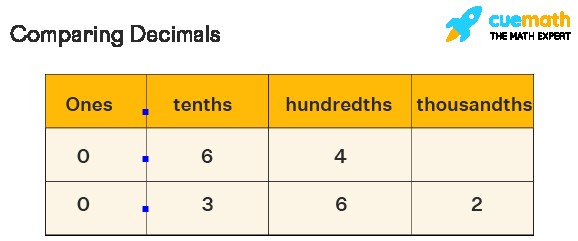Comparing decimals involves determining which decimal number is larger or smaller in a given set. This process is similar to comparing whole numbers, but requires considering the digits after the decimal point. These digits represent place values starting from tenths, then hundredths, thousandths, and so on. This article explains how to compare decimals effectively.
Understanding Decimal Place Value
Before comparing decimals, understanding place value is crucial. Each digit after the decimal point holds a specific value:
- Tenths: The first digit after the decimal (0.1)
- Hundredths: The second digit after the decimal (0.01)
- Thousandths: The third digit after the decimal (0.001)
And so on. The further a digit is to the right of the decimal point, the smaller its value.
Comparing Decimals Step-by-Step
Here’s a step-by-step guide on how to compare two decimals:
-
Compare Whole Number Parts: Start by comparing the digits to the left of the decimal point. If they are different, the decimal with the larger whole number is greater. For example, 12.5 is greater than 3.8.
-
Compare Tenths: If the whole numbers are equal, compare the digits in the tenths place. The decimal with the larger digit in the tenths place is greater. For example, 5.7 is greater than 5.2.
-
Compare Hundredths: If the tenths digits are also equal, move to the hundredths place and compare. Continue this process for each subsequent place value until you find a difference. For example, 7.34 is greater than 7.31.
-
Equal Decimals: If you’ve compared all corresponding digits and found no differences, the decimals are equal. For example, 0.250 is equal to 0.25.
Example: Compare 0.64 and 0.362
- Both whole numbers are 0.
- The tenths place digits are 6 and 3. Since 6 > 3, we know that 0.64 > 0.362.
Comparing Decimals and Fractions
To compare a decimal and a fraction, convert the fraction to a decimal:
-
Divide the numerator by the denominator. For example, to convert 3/4 to a decimal, divide 3 by 4, resulting in 0.75.
-
Compare the two decimals using the steps outlined above.
Using a Number Line
Visualizing decimals on a number line can aid comparison. Decimals further to the right on the number line are greater.
Conclusion
Comparing decimals is a fundamental math skill. By understanding place value and following a systematic approach, you can accurately determine the relative size of decimal numbers. Remember to practice regularly to solidify your understanding.
